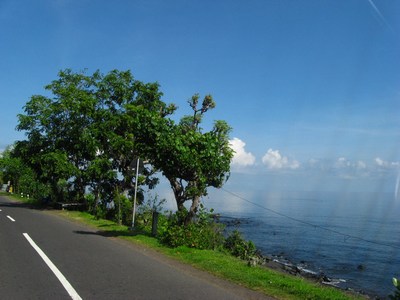 A majority of tourists that visit Bali and venture north rarely go past Gitgit Falls located halfway between Pura Ulun Danau Bratan and the former capital of Bali; Singaraja. The far north of Bali has so much to offer the traveller in terms of things to see and do, great accommodation and, a coastline that will astound any traveller who appreciates the beauty of nature.
A majority of tourists that visit Bali and venture north rarely go past Gitgit Falls located halfway between Pura Ulun Danau Bratan and the former capital of Bali; Singaraja. The far north of Bali has so much to offer the traveller in terms of things to see and do, great accommodation and, a coastline that will astound any traveller who appreciates the beauty of nature.
Of course the focal point is Singaraja with its Dutch colonial architecture and wide streets, but, taking the road left or right out of the city affords many delightful surprises. However, do take time out to explore the former capital of Bali because you will not regret it.
Singaraja:
Gedong Kirtya Museum and Library:
This is the only library in the world with a large collection of lontar manuscripts both ancient and sacred texts on leaves of the lontar palm. The building also houses books from the Dutch colonial era and some very interesting inscribed copper plates called prasasti. Not far from the Library is the museum which houses the collection of the last Raja of Buleleng.
Ling Gwan Kiong Chinese Temple:
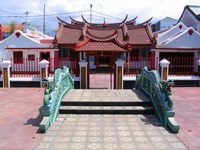 Just off Jalan Erlangga and a stones throw from the ocean sits the beautiful Chinese temple Ling Gwan Kiong. A colourful and beautifully constructed klenteng, access to the temple is via a water bridge over a pond filled with pink and white lotus flowers. Bhudda statues and ornately decorated textiles are to be found everywhere. Particularly impressive are the murals of Deities hand-painted on the entrance doors and surrounding walls.
Just off Jalan Erlangga and a stones throw from the ocean sits the beautiful Chinese temple Ling Gwan Kiong. A colourful and beautifully constructed klenteng, access to the temple is via a water bridge over a pond filled with pink and white lotus flowers. Bhudda statues and ornately decorated textiles are to be found everywhere. Particularly impressive are the murals of Deities hand-painted on the entrance doors and surrounding walls.
The Waterfront Harbour:
It is a quite place and there are some deserted and old Dutch warehouses to be found here but they are rundown but one can imagine the hive of activity that once occurred there. Take a stroll along the beach and have a look at some of the scattered traditional villages along this stretch. There is also a monument called Yudha Mandala Tama that was erected in 1987 and commemorates the independence struggle against the Dutch in the 1940’s.
Singaraja Central Market:
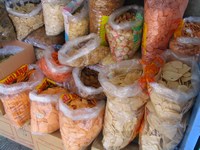 Located right in the centre of the city on the main street, this poky and dusty market is fabulous to meander through albeit a tad claustrophobiatic at times. The market is seldom visited by westerners so be aware of pilfering but it is a place where you an also get some great shopping and cheaper than in Kuta!. It is a general goods market meaning it has just about everything.
Located right in the centre of the city on the main street, this poky and dusty market is fabulous to meander through albeit a tad claustrophobiatic at times. The market is seldom visited by westerners so be aware of pilfering but it is a place where you an also get some great shopping and cheaper than in Kuta!. It is a general goods market meaning it has just about everything.
Lovina:
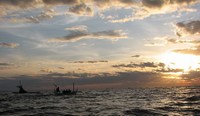 Lovina essentially consists of six traditional villages on a ten kilometre stretch of the main road which hugs the north coast – Temukus, Kalibukbuk, Anturan, Pemaron, Tukad Mungga and Kaliasem. It is a quiet area of Bali although it can get busy in July and August. The narrow black sand beaches are generally safe for swimming. At one time it was a popular tourist destination before the bombings, and now, there is a steady stream of tourists. There are an array of accommodation and a plethora of warungs and restaurants to choose from.
Lovina essentially consists of six traditional villages on a ten kilometre stretch of the main road which hugs the north coast – Temukus, Kalibukbuk, Anturan, Pemaron, Tukad Mungga and Kaliasem. It is a quiet area of Bali although it can get busy in July and August. The narrow black sand beaches are generally safe for swimming. At one time it was a popular tourist destination before the bombings, and now, there is a steady stream of tourists. There are an array of accommodation and a plethora of warungs and restaurants to choose from.
Dolphin Sighting:
Trips leave each morning and have very mixed reviews as the boats tend to outnumber the dolphins, but it can still be an enjoyable ride. June, July or August are the best time when the weather is good and the waters blue and clear. There are some 300 dolphins in the area. Prices are fixed.
Pengastulan:
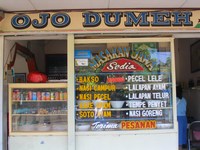 Like most towns in Bali, the prominent wide tree-lined streets of Pengastulan are a pleasure to drive down, and, the usual array of shops and warungs are scattered here and there. Pengastulan is truly a great place to stopover on your way to Lovina in the east, or, to take the north coastal road to Gilamanuk. The great attraction near the town has to be the Vihara.
Like most towns in Bali, the prominent wide tree-lined streets of Pengastulan are a pleasure to drive down, and, the usual array of shops and warungs are scattered here and there. Pengastulan is truly a great place to stopover on your way to Lovina in the east, or, to take the north coastal road to Gilamanuk. The great attraction near the town has to be the Vihara.
Brahma Vihara Arama:
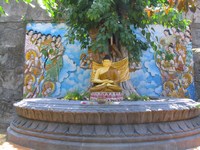 Brahma Vihara Arama is located SW of Lovina, 3 km inland from the town of Dencarik. Built in 1970, Brahma Vihara Arama is popular with Buddhist visitors form all over Asia and is a unique place. The location on the northern slope of the mountains, affords wonderful view of the north coast.
Brahma Vihara Arama is located SW of Lovina, 3 km inland from the town of Dencarik. Built in 1970, Brahma Vihara Arama is popular with Buddhist visitors form all over Asia and is a unique place. The location on the northern slope of the mountains, affords wonderful view of the north coast.
Brahma Vihara Arama has elements of Balinese Hinduism which include a couple of terrifying naga either side of the entrance and a Balinese Hindu kulkul (wooden bell) tower. The bell shaped structures, made of blocks of dark stone remind me of Borobudur in Central Java.
Air Sanih:
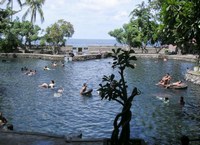 Air Sanih is located 17 km from Singaraja. The springs are surrounded by garden and there are changing facilities and the water is ice-cold freshwater spring. Since 1930, Air Sanih has been well known as a tourist attraction for locals. People believe that the water comes from Lake Batur. You will also find a temple by the pool dedicated to Lord Vishnu. The small tourist scene that is set up here also attracts locals who love a late afternoon soak in the springs. Can be a good way to relax and check out the local scene also.
Air Sanih is located 17 km from Singaraja. The springs are surrounded by garden and there are changing facilities and the water is ice-cold freshwater spring. Since 1930, Air Sanih has been well known as a tourist attraction for locals. People believe that the water comes from Lake Batur. You will also find a temple by the pool dedicated to Lord Vishnu. The small tourist scene that is set up here also attracts locals who love a late afternoon soak in the springs. Can be a good way to relax and check out the local scene also.
Pura Beji:
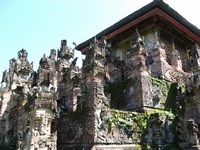 This magnificent temple was built around the 15th Century and being a subak temple it is dedicated to the Goddess Dewi Sri (the goddess of rice in the Balinese Hindu religion). The front wall of the temple shows rewards that await the godly in heaven and the punishments awaiting the evil in hell. It is a perfect example of the rococo style of temple carving with animals, plants, and monsters motives and interspersed with demon heads.
This magnificent temple was built around the 15th Century and being a subak temple it is dedicated to the Goddess Dewi Sri (the goddess of rice in the Balinese Hindu religion). The front wall of the temple shows rewards that await the godly in heaven and the punishments awaiting the evil in hell. It is a perfect example of the rococo style of temple carving with animals, plants, and monsters motives and interspersed with demon heads.
It is the off-angel symmetry of some of the gateways that is interesting. The massive inner courtyard is adorned with frangipani trees and neatly trimmed lawn, wooden statues and a stunning padmasana of the sun-god. You will find carved into the walls the images of what is perceived to be Dutch soldiers playing musical instruments. Extremely bizarre.
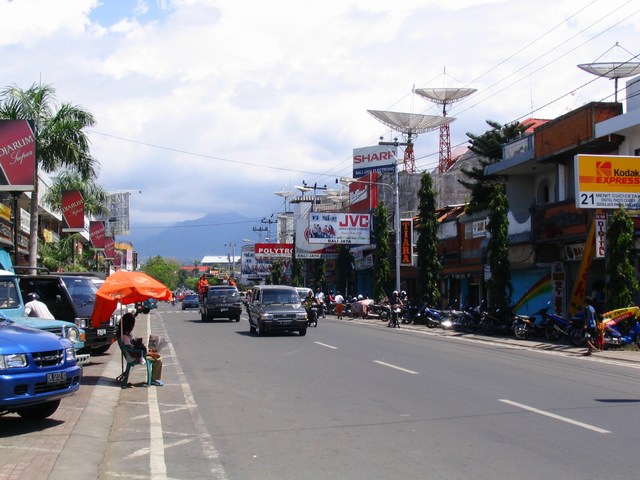
Downtown Singaraja